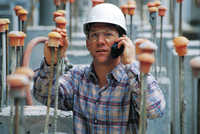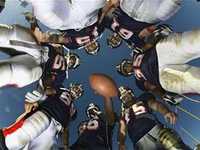| Home | About | Archives | RSS Feed |

The Independent Investor: Vocational Schools — A Youthful Answer to Unemployment
 |
If you think a 7.8 percent unemployment rate in this country is terrible, ask an unemployed 18-year-old how their job search is going.
I'll tell you, not well. Today, unemployed workers between the ages of 16 and 19 years old have an unemployment rate of more than 23 percent, according to the Bureau of Labor Statistics. That number falls to 20.9 percent among white kids and explodes to 39.3 percent for African-American youths. The dismal fact is that for America's young adults unemployment is 30 percent higher than the national average.
Youth unemployment is worse than at any time since the Great Depression and will remain stubbornly high largely because the young lack the experience and skills of older workers. So if you believe, like I do, that young people represent the future of this country, something better be done to turn these numbers around and pronto.
In my last column, I wrote that trade/vocational schools were making a comeback. And as this century picks up speed the demand for skilled workers in a variety of high-paying, blue-collar areas is going to accelerate. For many of today's unemployed youth, vocational training should be a no-brainer. Here's why.
Vocational training requires less time to complete than a college degree since most postsecondary vocational degrees can be had in two years. Unlike your college-educated brethren, you will have readily employable skills, therefore you can be working and earning money in as little as 24 months while many college grads will still be searching for a job. And you will do so without an enormous educational debt burden that most college grads will be required to pay down over the next 15-20 years.
But the future of vocational training, in my opinion, must do more. It must reach backward into our high school system. That's where the student's technical training should start. Let's face it, not everyone should go to college, nor do they want to. Yet, for the most part, our educational system is geared for that single objective. That is a big mistake.
Some students, maybe a lot of students, won't be attending college. What about them? Given the high cost of a college education today, many lower and middle income students already know they can't afford college. So why, they ask, should they even remain in a high school dedicated to preparing them for a college they will never attend?
I say bring back shop classes. Why not allow those students to spend at least half their time in a trade area, alternating a full week of career education and a week of academics?
What about trying a Swiss or Netherlands-style vocational education approach? In their systems, students in their last two-years of high school have the option of participating in a structured workplace apprenticeship, making money some of the week while spending the rest of the time in the classroom. That might explain why the Swiss unemployment rate among youths is only 5 percent.
Consider that in the Massachusetts' vocational technical high schools the dropout rate is half the rate of those at comprehensive high schools, according to a recent study by Pioneer Institute, a Boston-based research firm.
Why? Students, who are given a choice between preparing for college (the comprehensive approach) or preparing to learn a skill or trade, feel they have more control of the future. In addition, the academic and applied learning environment in mastering a vocation of their choice tends to keep the student's attention and reinforce their commitment.
Finally, the more a student can apprentice while in the classroom the better. Apprenticeships, in combination with academic education, will improve the transition from schools to careers and higher paying jobs. It can upgrade skills and fine tune them to the needs of our nation's companies. I say urge our nation's businesses to return to the apprenticeship and training model. It worked well in this country for decades and works splendidly today in Germany, Austria and other European countries.
President Obama, in his State of the Union address, appears to recognize the need for a change of direction in how we are educating and training our youth for the challenges ahead. I say he is on the right track. What do you say?
The Independent Investor: Trade Schools versus College
 |
The Independent Investor: America, the Battered
 |
On the eve of what is supposed to be one whopping big snow storm here in the Northeast, one can only wonder if Mother Nature is preparing us for yet another horrendous weather year. Last year was one of the costliest on record.
In 2012, at least 11 weather events, each causing more than $1 billion in losses, were delivered upon this nation. Tornados, hurricanes, wildfires, and drought were just some of the fire and brimstone that left 349 people dead while leaving millions of inhabitants seeking shelter.
Out West, those "purple mountain majesties" were hidden by months of thick smoke as almost 10 million acres of national forest was reduced to blackened stumps. At the same time, those "fruited plains" and "amber waves of grain" shriveled away, replaced by acres of cracked, parched earth. After months of waterless weather, the 2012 drought spread over half the United States, from California, north to Idaho and the Dakotas and then east to Indiana and Illinois. Think "Dust Bowl."
That drought persisted all year and continues today in much of the nation's mid-section. Over 123 of those deaths and billions in damages can be attributed to that drought alone. Of course, the drought played a major role in spreading the wild fires, which gave us our second worst fire season in over a decade in the western U.S.
One can only wonder how the high temperatures interacted with other weather conditions to trigger an unrelenting series of tornados and severe thunderstorms in places like Texas, Oklahoma, Colorado and much of the Southern Plains. Forty-eight deaths, countless casualties and $14.5 billion in damages had many residents in a dozen states as shell-shocked as war victims.
There was even an unusual combination of high winds and severe storms (called the Derecho Event) that cut a swath of death and damage through the mid-Atlantic from New Jersey to South Carolina this summer. It caused 28 deaths and $3.75 billion in losses.
There was also little left shining from "sea to shining sea" except search lights during the nation's two largest hurricanes: "Isaac," which blew in from the Gulf of Mexico and Hurricane Sandy that made a shambles of much of the East Coast.
It was Sandy that skewed the numbers last year. The Superstorm killed 131 people and estimated damages have peaked at $50 billion. Only 2005, the year of Hurricane Katrina, Wilma, Rita and Dennis, generated more deaths (2,000) and worse damage ($187 billion). And the damage caused by Mother Nature is on the increase.
Back in the '80s and '90s, according to the National Climatic Data Center, which is part of the National Oceanic and Atmospheric Administration, it was rare to see more than two or three $1 billion, weather-related damage events annually. We had many years where the losses totaled less than $20 million a year. But today, the standout years during those decades have now become fairly common. Billion-dollar events have become twice as frequent as they were back in 1996 and in the proceeding 15 years.
So as you read this today, "Nemo the Nor'easter," will have descended upon us. It is forecasted to pile up the white stuff at the rate of an inch an hour around here. Over in Boston, it could be much worse. Let's hope everyone survives it. Unfortunately, this may only be the first big weather event of many that we will endure this year. In which case, 2013 will simply be adhering to what is now the new normal in weather-related costs.
C'mon, Mother Nature, go pick on someone else.
The Independent Investor: The Business of the Super Bowl
 |
It is one of the few businesses that continues to grow year after year. Whether one looks at the ads, the attendance or the number of television viewers, the Super Bowl has survived where others of its species have died off. It is truly one of the last mass-audience live television events of our society.
Super Bowl XLVII will be played on Sunday, Feb. 3, in the Mercedes-Benz Superdome in New Orleans. It will mark the 10th time the "Big Easy" hosted the event. The last one was in 2002. It could mean as much as $450 million in business for the city.
Now, that would only be half as much as New Orleans has spent preparing for the game. The city spent more than $1 billion on infrastructure improvements, including renovations at the airport, a new streetcar line, and enhancements to the Superdome itself. After the devastation of Katrina, New Orleans needed to rebuild and have used a number of major sporting events, including the NCAA men's basketball Final Four in 2012, a couple of BCS National Championship Games and the NBA All-Star Game in 2008 to do just that. But the Super Bowl is the big jambalaya in the menu of possible events.
Experts say that for every $100 spent in the city, about 50-70 percent remains there, while the rest leaks out into other surrounding locales. New Orleans, like other cities who have hosted the event, is hoping that by putting their best foot forward, they will convince some of the attendees to remain and even establish businesses in the areas.
Given that the attendance at the Super Bowl is largely a corporate event, businesses get first choice of rooms, flights, special events and just about everything else involved in the Super Bowl and the days surrounding it. The chance to shine cannot be underestimated and the city fathers know it.
For those of us unable to attend the live event, all is not lost. We can look forward to countless parties (either at home or your favorite bar or cafe), root for your favorite team, dance to the half-time show (Beyonce will man the stage this year) and, of course, watch the commercials.
Americans continue to watch the Super Bowl in record numbers. More than 46 percent of TV households watched last year's game, according to Nielsen, which makes it just about the most watched broadcast in U.S. history. And the wealthier you are, the more likely you are to tune in. For advertisers, who strive to reach the age demographic of 18-49 years old, the Super Bowl is the best game in town.
It is probably why Super Bowl ads keep climbing in cost. Ad slots for this year's game sold out at the asking price of $3.5 million per 30-second spot by December. That is up from $3 million/spot last year. But corporations will pay it because there is a gold mine for those who can come up with the right ad.
This year, viewers will see some big names populating the ads. Singer Beyonce, hip-hopper Jay-Z, supermodels Catrinel Menghia, Bar Refaeli and Kate Upton. And that is only a taste of the lineup. Personally, I will be looking forward to the return of the French bull dog, Mr. Quiggly, (which replaced Kim Kardashian in a Skechers' ad). Last year he captured the hearts, minds and pocketbooks of many of us.
There will also be a number of new ad sponsors this year including Oreos. For me, the day after the event will be as much about my favorite commercial than it is the game. That's why the Super Bowl has become such a business generator for corporations.
Given that the ads are 58 percent more memorable than your average TV commercial, I can see why. If you doubt that, just recall the ad with the little boy dressed as Darth Vader. I bet you can even remember what auto manufacturer sponsored it. That company reaped a cool $100 million in free publicity from the spot, which is not bad for $3.5 million investment. When it comes to the Super Bowl, what is good for business, is also good for America, so let the games begin and the cashier register ring!
The Independent Investor: Get Ready for a Surprise
 |
Pay special attention to the new disclosure box when you open your year-end, 401(k) statements. That's where you will discover for the first time just how much you are paying for the privilege of investing in those company-sponsored menus of mutual funds. You may be in for a surprise.
More than 70 percent of all 401(k) participants fail to realize that they are paying fees for investing in these tax-deferred retirement plans, according to an AARP study. I have to agree. Over the years, I have met with many prospective clients who had not rolled their 401(k) over to an IRA once they retired. They were under the impression that keeping their savings plan with their company offered a fee-free benefit for life. Nothing could be further from the truth.
The Department of Labor, after many delays and postponements, has finally forced employers, advisers and fund companies to own up to just how much they have been charging you, the employee, for this fringe benefit. Longtime readers may recall my past columns concerning the battle to prevent these fees from becoming public knowledge. Wall Street has lost that battle but probably not the war.
The problem, you see, is that consumers may simply fail to comprehend the long-term impact of these fees on their retirement savings. Let's say you open your statement and discover that you are paying a $100 in expense ratios (fees), per mutual fund each year. That may not mean much when the overall worth of the account is $10,000. What you fail to understand is that over the life of contributing part of your paycheck towards retirement — 20 or 30 years — those fees will add up.
Demos, a policy research firm, recently released a study which revealed that a two-income family, earning average wages, will lose $155,000 or about 30 percent over the life of their savings plan, to these Wall Street fees. That is in line with most independent studies on the subject which indicate you will pay one-third of your retirement savings in fees.
Wall Street defends its fees and has released its own studies that show the average investor pays less than $248 a year in 401(k) fees and no more than $20,000 during the life of the plan. Even if they are right, given that the average 401(k) in this country is around $75,000, that still results in over 26 percent of the plan consumed by fees.
So what can you, the employee, do about it? Your first reaction may be to stop investing in your 401(k). That would be a big mistake. These deferred savings plans have at least two major benefits over an IRA. The employers' "match" whereby your company contributes dollar for dollar up to a certain percentage of your own contribution is free money and worth any contribution you make.
Second, the government allows you, the employee, to contribute much more to a 401(k) than to an IRA. This year employees can contribute $17,500 to their 401(k) plans and, for those over 50 years of age, an additional $5,500 can be contributed. That compares to just $5,500 (or $6,500 for those over 50) in contributions to a traditional IRA.
However, you can cut down on the fees by urging your company representative to select mutual fund families with the lowest fees possible. That's what I do every day for my clients. Better yet, tell the company to abandon mutual funds altogether and invest in exchange traded funds (ETFs) instead. Some 401(k) plans already offer ETFs. These index funds are much cheaper than their high-priced cousins and outperform comparable mutual funds over 80 percent of the time.
Remember, too, that you are managing your own 401(k). That puts the onus on you to decide what investments to make and when to move to the sidelines. That's tough to do when few of us have the professional knowledge to cope with today's markets. Part of my job is to advise my non-retirement clients on how to invest those savings and when. It is also one of the reasons I write these columns. Hopefully, it gives you, the reader, some advice on how to manage your retirement savings.
Finally, if you are retiring soon, my advice is to plan to roll over your 401(k) savings into a traditional IRA. You likely will enjoy a cost savings of as much as 1-2 percent annually. You will also be able to expand your investment choices from the limited menu your company plans offers. If you need advice on how to accomplish that give me a call. It is much easier to do than you might think.
Bottom line: the new fee disclosures is a giant step forward for you the consumer but now that you know how much you are paying, it is up to you to do something about it.

